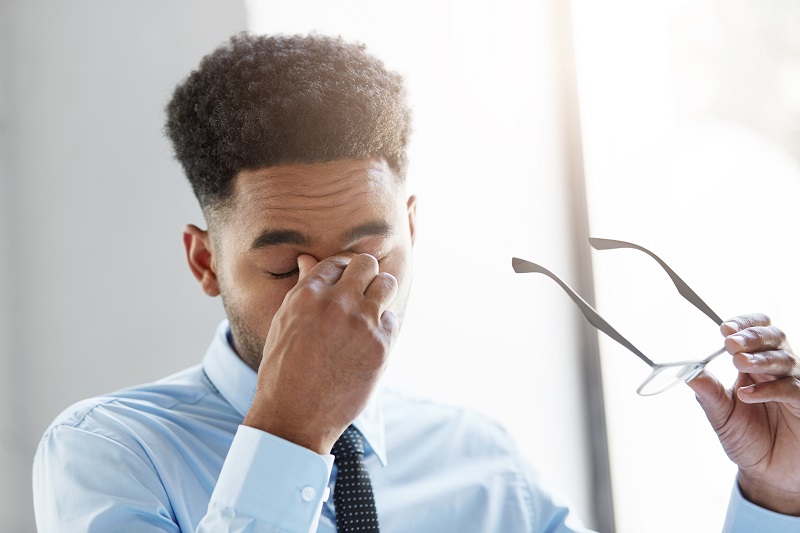
July Is UV Safety Month

Don’t Forget to Protect Your Eyes
According to the U.S. Department of Health & Human Services (HHS) “The harmful ultraviolet rays from both the sun and indoor tanning sunlamps can cause many other complications besides skin cancer – such as eye problems, a weakened immune system, age spots, wrinkles, and leathery skin.”
UV exposure can cause cataracts, macular degeneration and corneal damage, and can even lead to blindness. There are things you can do today to help protect your eyes when you are outdoors or driving. How? When you are enjoying the sunshine, always wear wrap-around sunglasses with a 99% or higher UV block rating and a wide-brimmed hat.
What Causes Eye Pain?

Many people experience eye discomfort at some point in their life. Some situations require no medical intervention. Others are more severe and can indicate an underlying health issue. It is best never to ignore unexplained eye pain.
Where Is the Pain Coming From?
The first step is to figure out where the pain is coming from. Our eyes are made up of different parts, each serving a different purpose.
- Eyelids – The exterior covering of the eye.
- Extraocular muscles – Muscles that rotate your eyes.
- Nerves – Internal network that carries information to the brain.
- Orbit – Also known as the eye socket, this is the part of the skull that houses the eye.
- Iris – The colored area of the eye that surrounds the pupil.
- Conjunctiva – Thin covering that protects the sclera.
- Sclera – Known as the whites of the eye.
- Cornea – Clear structure in front of the eye that directs light rays.
Common Causes of Eye Pain
Many conditions can cause eye pain. Some of the more common include:
- Foreign body – If something gets in your eye, it can cause persistent discomfort until it is removed. Most things can be washed out with water or artificial tears.
- Corneal abrasions – Corneal abrasion refers to a scratch on the cornea. This can happen from rubbing your eye or trauma. A doctor may prescribe antibiotic drops to help heal the injury.
- Conjunctivitis – Conjunctivitis is better known as pink eye. It is an inflammation of the conjunctiva that occurs due to infection or allergy.
- Corneal infections – Also known as keratitis, corneal infections can be caused by a virus or bacteria.
If you experience eye pain or other symptoms, seek medical advice right away. Contact Grosinger, Spigelman & Grey now to schedule an appointment with an ophthalmologist.
Workplace Eye Wellness

March is Workplace Eye Wellness Month, and it is a great time to learn more about protecting your vision while on the job. Almost 25,000 Americans rush to emergency rooms for a workplace eye injury each year. More than 2,000 suffer an eye injury daily. That translates to nearly one million U.S. citizens who have lost vision and over $300 million in lost wages, workman’s compensation, and medical costs.
How to Protect Your Eyes At Work
The risk to your vision will vary based on your occupation. The construction industry currently claims one of the highest injury rates per the National Institute of Occupational Safety and Health. Common causes include:
- Hazards created by nearby coworkers
- Windy or dusty conditions that cause particles to enter the eye
- Exposure to arcs and flashes from welding
- Hammering metal which launches metal slivers or nail rebounding
- Wood, metal, dust, drywall, cement, or slag contacting the eye
Safety Starts with Following the Rules of Safety
Every worksite should have rules of safety to protect the vision of all. Engineering controls should be in place that includes machine guards that can catch particles. Welding curtains are also necessary to shield eyes from arc flash.
Administrative measures should also be in place. This includes having off-limits areas that are only accessible to employees who must be there to complete specific tasks. Finally, always wear proper protective eyewear. If you do receive an eye injury, go directly to the emergency room.
Contact Grosinger, Spigelman & Grey Michigan’s Leading Eye Care Physicians in Bloomfield Hills to schedule an appointment.
Does Stress Affect Eyes?

Most people know that stress can have a negative impact on their health and wellbeing. It is often associated with headaches and fatigue. However, did you know that stress can also affect your vision?
Fight or Flight and Your Eyes
Stress can trigger certain reactions within your body. Long ago, these reactions would cause us to go into fight or flight mode to deal with a physical threat. Today, stress can be caused by many non-physical issues like an argument with a loved one or problems at work. Our bodies don’t differentiate between the different types of stress. Instead, they react the same way they used to: by producing adrenaline and other hormones.
If you sustain this state for a long time, it can cause eye problems. Constant dilation can bring on light sensitivity and strain. If you’re tense, you may tighten muscles in your face and around your eyes which can cause soreness. Common stress-related symptoms include:
- Tunnel vision
- Eye twitching
- Light sensitivity
- Blurred vision
- Eye floaters
- Eye strain
How Can I Reduce the Effects of Stress On My Eyes?
The first thing you should do if you notice stress-related symptoms is to find ways to relax. A warm bath, exercise, meditation, and deep, slow breathing can help. If you experience chronic stress, then you may need to see a doctor or therapist. If you notice any changes in your vision, contact Grosinger, Spiegelman & Grey ophthalmologists for an appointment.
Do Eyeballs Freeze?

The answer; not really BUT it is ill advised to force your eyes open in excessively frigid temperatures especially with gusty winds as your cornea can freeze or your contact lenses can freeze to your eyeball.
Luckily, any damage usually heals within weeks if not sooner, but not always. There are those that have tissue loss and need restorative surgery. So, it is best when outdoors in extreme cold temperatures like we are experiencing now to wear proper goggles or eye wear to protect your eyes.
Swimming and Your Eyes

Avoid wearing contacts if possible in the water. If you are an avid swimmer, you may want to invest in prescription goggles. If you must wear contacts, make sure you properly clean them immediately after swimming to prevent eye infections. If you think you may have an eye infection, contact Grosinger, Spigelman & Grey to make an appointment.
Do I Have Something in My Eye That Needs Medical Attention?

The external eye encompasses the parts of the organ that are primarily on the outside like the eyelids, cornea, and surrounding tissues. It also includes the anterior chamber, which is a fluid-filled space between the iris and cornea. When an object becomes lodged in this region, it must be removed to prevent damage and discomfort.
Signs of a Foreign Body in the Eye
You may notice a number of symptoms when something finds its way into the external eye. These are generally unpleasant sensations and can vary in severity. Common signs include:
- Eye pain
- Feeling pressure in the eye
- An irritating sensation in the eye
- Excessive tearing
- Excessive blinking
- Eye redness
- Pain when looking toward light
Common Causes of a Foreign Body in the Eye
We come in contact with many everyday things that could become lodged in the eye. In fact, some are produced by our bodies. Common causes include:
- Contact lenses that are dirty or torn
- Sawdust, dirt, or sand
- Stray eyelashes
- Dried mucus
- Cosmetics and beauty products
- Glass shards
- Metal particles
When to See an Ophthalmologist
Many people manage to wash debris from their eye without any problem. For example, something like a loose eyelash can probably be removed without the need for further medical treatment. Some situations can turn into an eye emergency that requires immediate medical attention. You should go to the emergency room or see an ophthalmologist right away for the following:
- The debris has rough or sharp edges
- The debris is big enough to get in the way of blinking
- The debris contains any chemicals
- The debris entered your eye at a high rate of speed
- The debris is embedded in your eye
- Any eye bleeding occurs
A quick response can save your eyesight in these situations. Always wear proper eye protection when engaging in high risk activities like sports. Contact Grosinger, Spigelman & Grey Michigan’s Leading Eye Care Physicians if you have questions about proper eye care or foreign body removal.
Eye Injuries from Laser Pointers – What to Know to Protect Your Eyes

Laser points range from a practical tool to a fun toy. They are available everywhere and appear as a safe, unassuming device. What harm could a little pocket-sized light do to a person? The reality is that, under the right conditions, they can cause severe damage to eyesight.
The Power of a Laser Pointer
The damage a laser pointer can do depends on two factors: its power and how long it is shined in an eye. The higher the power of the device, the smaller the time margin for safe exposure. This is especially important when using pointers over five milliwatts. Many laser pointers are not properly labeled and are often sold as toys for children.
What Do I Do After Being Blinded by a Laser Pointer?
When a laser pointer shines on a person’s eye, they will initially notice a bright flash. If possible, you or someone with you should look at the device and its rating to determine if a medical assessment is needed.
The Food and Drug Administration (FDA) is responsible for classifying light-producing devices. Regulations outline different classes, with a class 2 being safer than higher number classes. Most laser pointers produce one to five milliwatts, which falls into subclass 3A. Those that are on the high end can cause damage while those on the lower end are not likely to cause permanent harm.
Safe Laser Pointer Practices
The following tips will help you use a laser pointer safely
- Always angle the laser pointer away from your face or the faces of others
- Never look directly into the light-producing end of a laser pointer
- Never use a laser pointer when driving or operating heavy machinery
- Never point a laser toward streets or high-traffic areas
- Be aware of nearby reflective surfaces like mirrors or metal objects
Contact Grosinger, Spigelman & Grey Michigan’s Leading Eye Care Physicians for an appointment if you have questions about your vision, are in need of a comprehensive eye exam or experience a change in eyesight.
#GrosingerSpigelmanGrey #MichigansLeadingEyeCarePhysicians #EyeMichigan #LaserPointers #EyeExam
Celebrate Workplace Eye Wellness Month with Better Work Habits

Workplace Eye Wellness Month is coming this March. It’s a good time to evaluate your current work habits to look for ways to keep your vision safe while at work. When most people think of careers with risks, they usually envision construction or other fields that require physical labor and machinery. The reality is that many other professions also come with risks, like office jobs that involve the use of computers.
Check Your Eyewear
Always use proper eyewear at work. The right type will depend on the job you are doing. Office jobs may only require a pair of prescription glasses or contacts as needed. Professions that involve tools, machinery, or chemicals may demand heavy-duty safety goggles.
Make sure your eyewear is in good, functioning condition and replace or repair immediately as needed. Even if you don’t need goggles, your prescription glasses or contacts should always be the correct strength to prevent eyestrain. Talk to your ophthalmologist right away if you notice a change in your vision.
Follow the 20-20-20 Rule
The 20-20-20 rule is very important today with more jobs involving the use of computers. This guideline prevents digital strain by setting a time limit for your eyes. The rule states that after 20 minutes spent looking at a computer screen, you should stop and focus your eyes on an object that is 20 feet or more away for at least 20 seconds.
An Eye-Friendly Workspace
Setup your workspace so that it is eye-friendly. Keep protective gear you need close by and use it. When working on a computer, use an anti-glare screen and position the monitor at a right angle away from light sources.
Also, remember to undergo regular comprehensive eye exams. Contact Grosinger, Spigelman & Grey Michigan’s Leading Eye Care Physicians to schedule an appointment.
#GrosingerSpigelmanGrey #EyeMichigan #MichigansLeadingEyeCarePhysicians #WorkplaceEyeWellnessMonth
